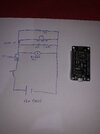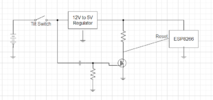hello everyone from Greece. I have a simple circuit for a fishing alarm. Basically i use a tilt switch for sensor, two leds and one buzzer. Its a simple circuit with low cost materials. I would like to go it to the next step. I will make 6 of this circuits for my fishing rods. Here is my question. How can i make a simple rf system to have receiver for each rod ? I need about 200meter distance. Also i would like to have separate signal for each transmitter to recognise witch rod has a bite. I post a video of an example https://www.aliexpress.com/item/4000341609254.html










